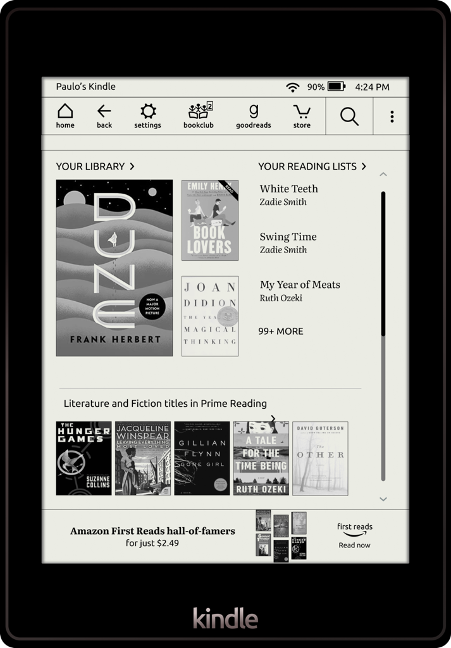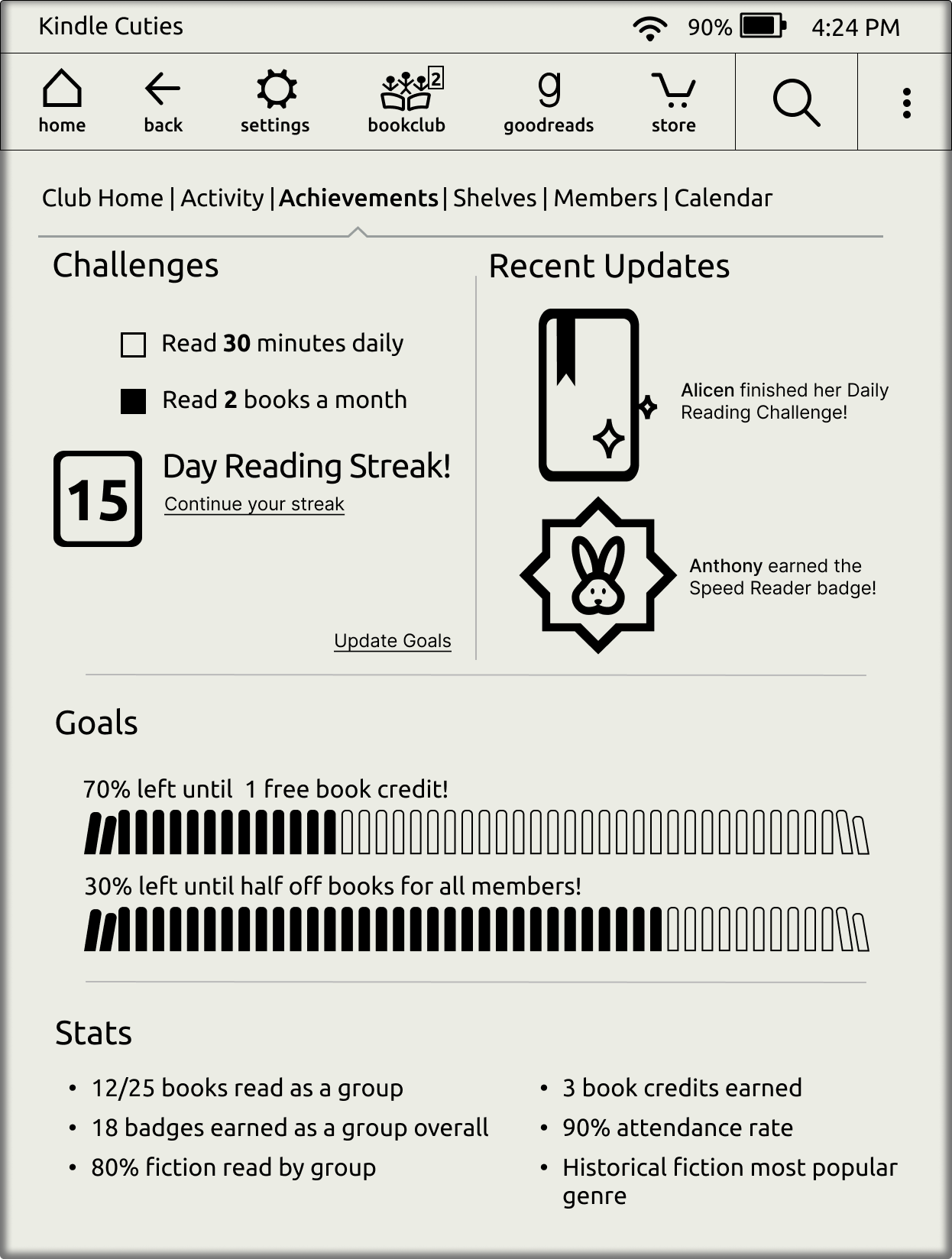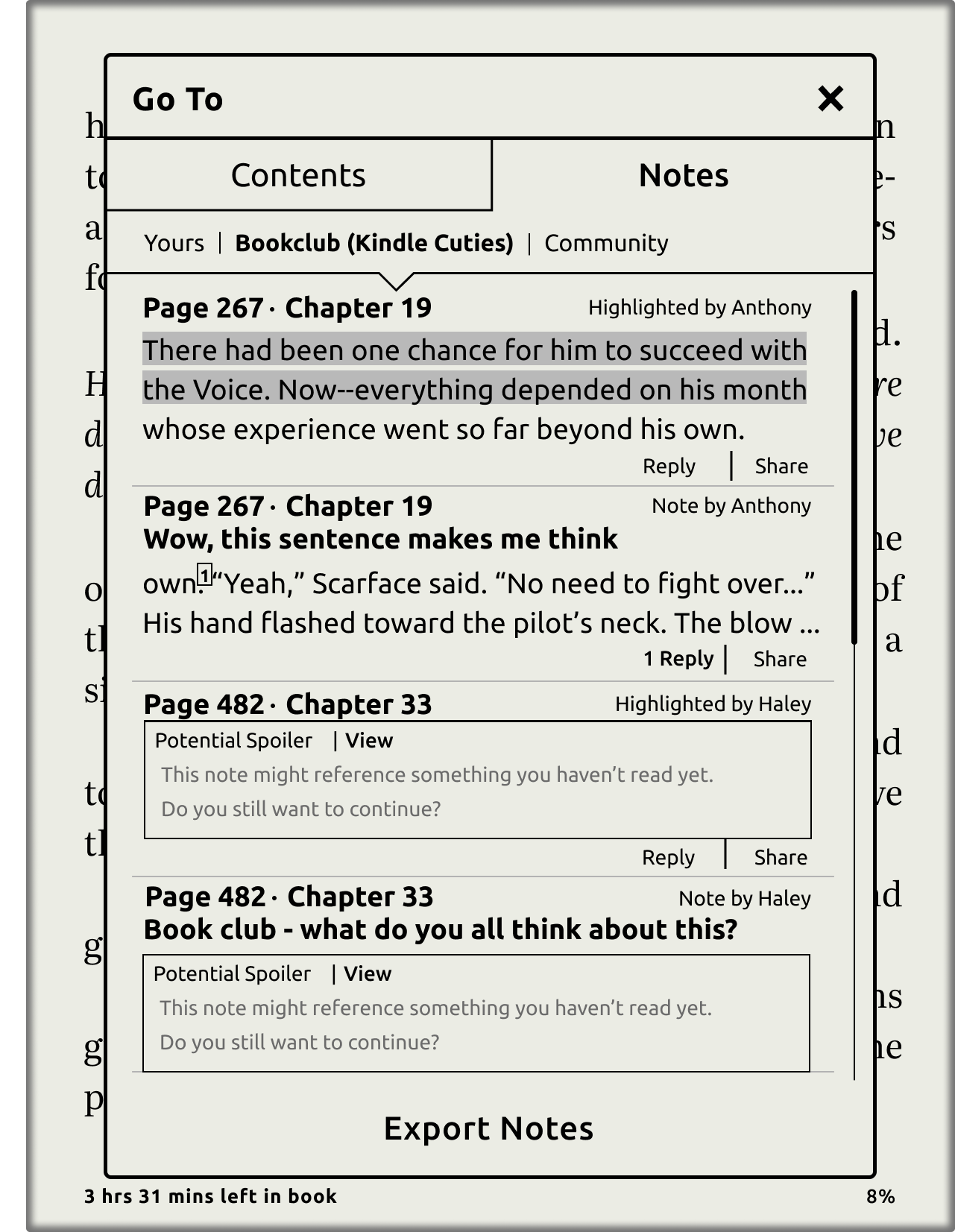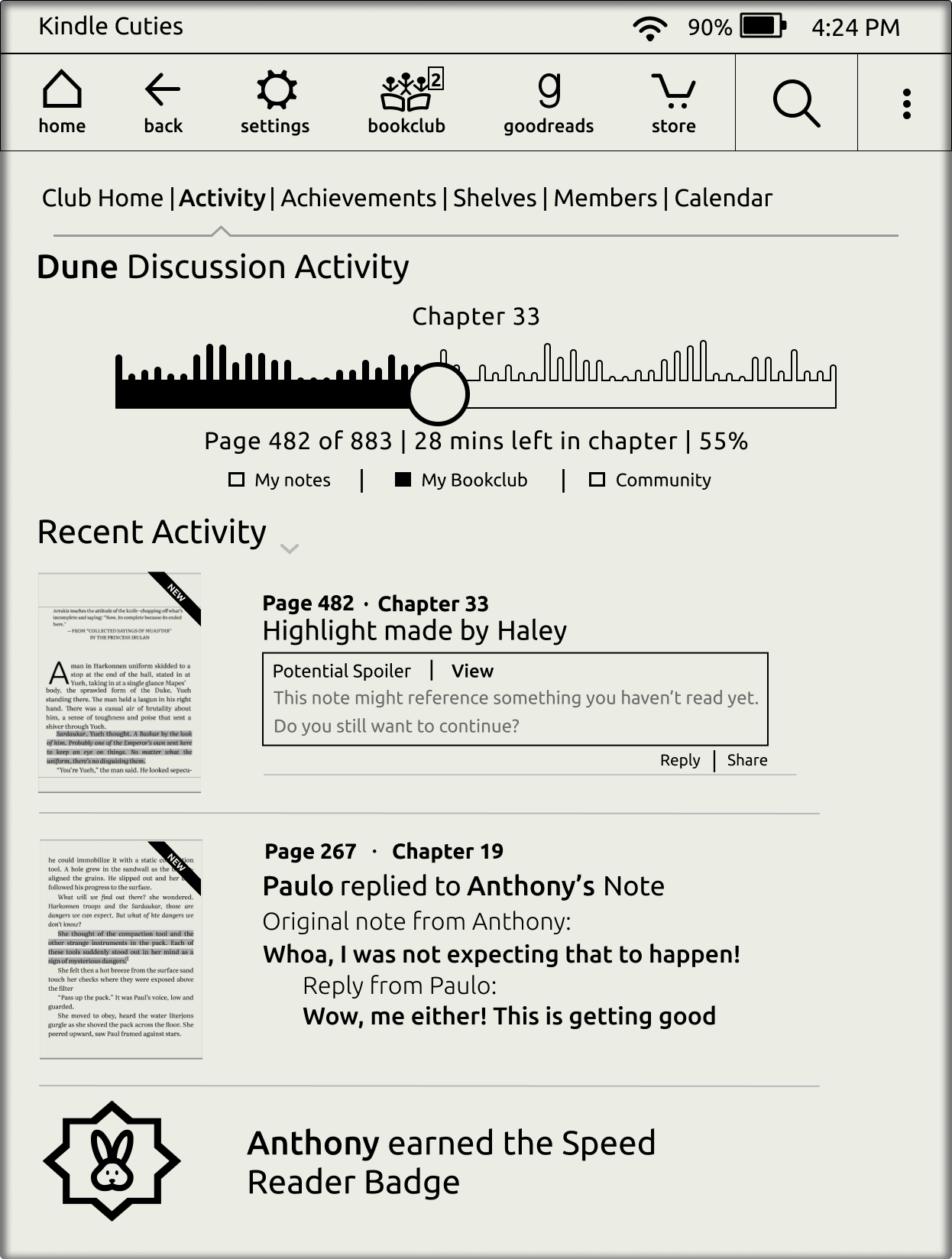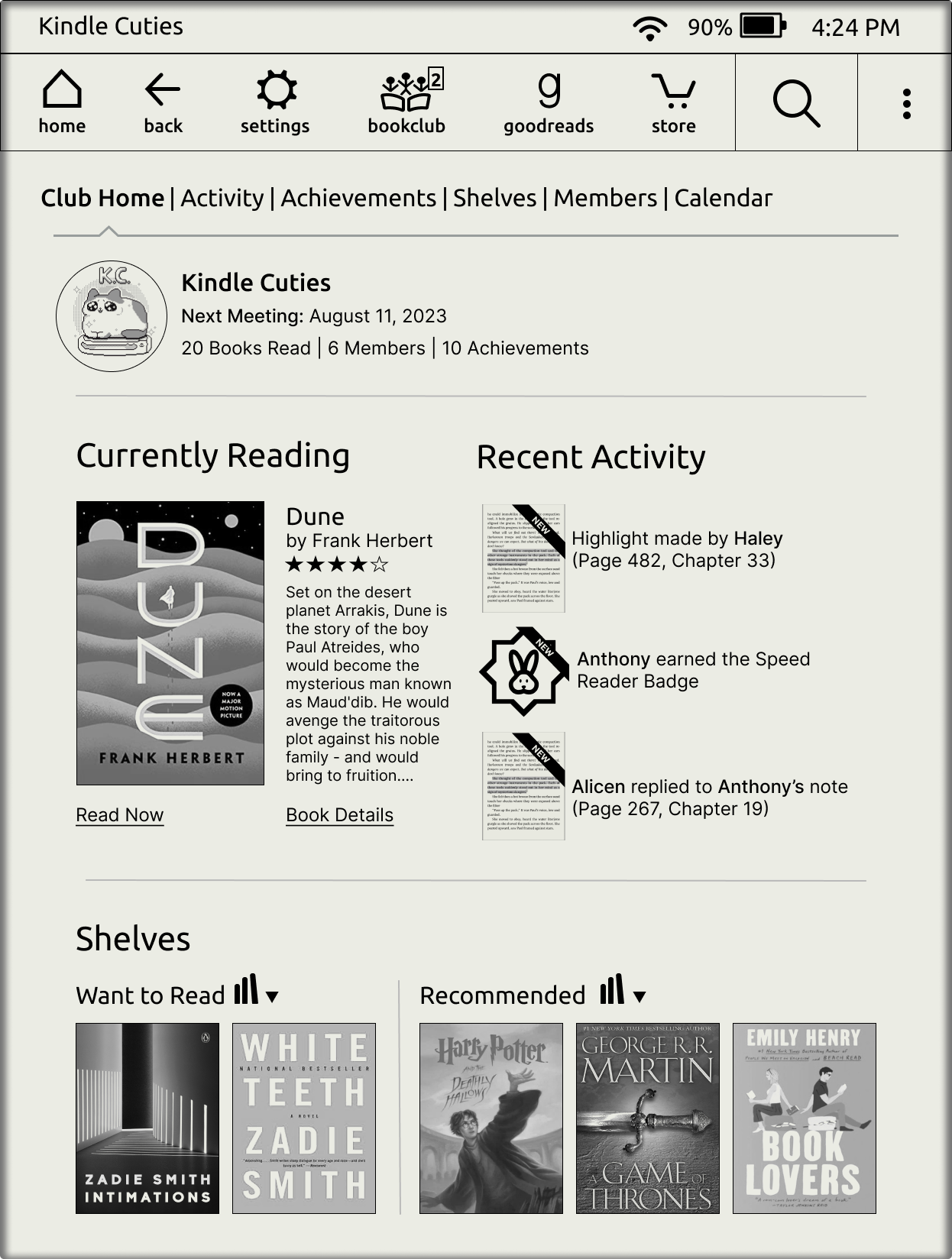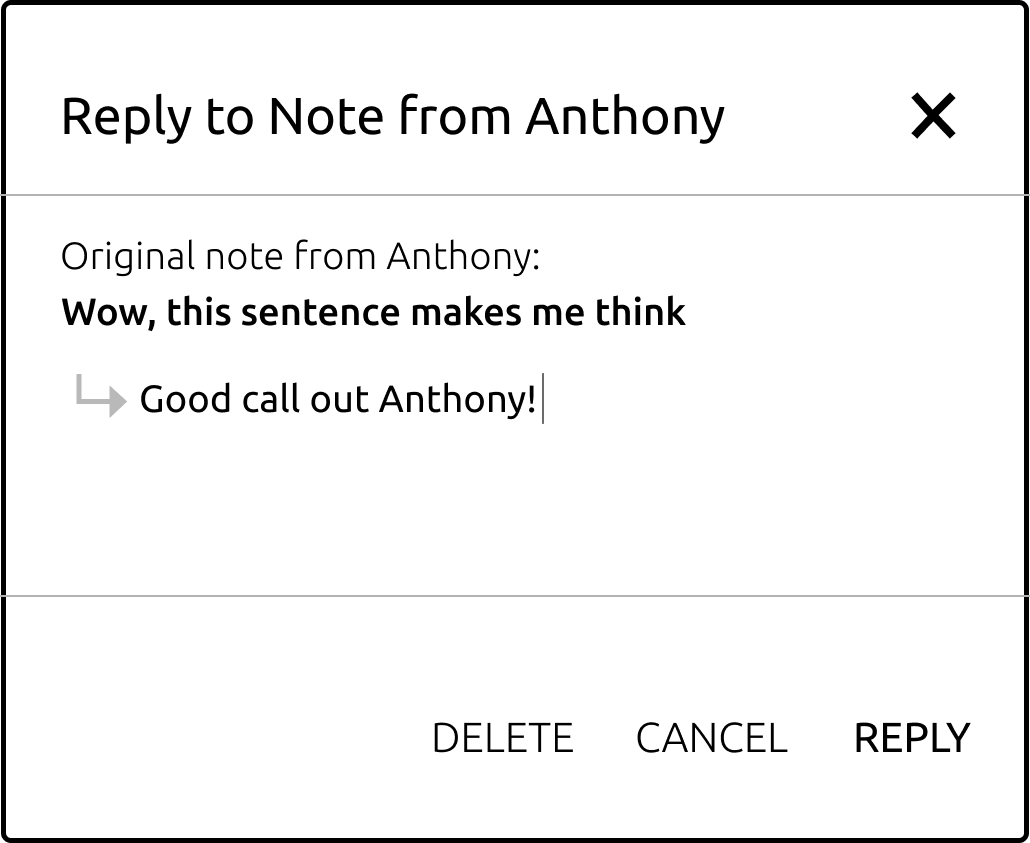
Kindle Bookclub
Research Lead: Alicen Matthews | Planning Lead: Haley Jacobson | UI Lead: Anthony Sudol
Timeline: 3 Weeks
Programs used: Figma, Figjam, Notion | General Assembly Student Project |
Kindle was first introduced in 2007, and while successful, people are still hesitant to make the switch from physical books to e-readers. It is tough to argue against a slim device that could store over 1000 books while weighing less than 7 ounces, but for many that is not enough of a reason to leave behind books.
This leads us to our assignment, breaking Kindle into a new and exciting space. Our task: How can Kindle become the preferred method of not only reading, but sharing progress and reflections with others? We chose to focus on book clubs to maximize the communal aspect of reading.
GOALS:
Discover motivations for joining book clubs and willingness to engage with community features
Determine the most well-liked features of clubs that people are currently a part of
Discover pain points in the current ways that people participate in book clubs.
KEY FINDINGS:
As the research lead I developed a research plan to ensure we were meeting the needs of our users. During our research we conducted a competitive and comparative analysis and created a feature inventory, where we found a gap in the market; no services or devices offer in-text discussion while reading and group book club management. We are hoping to bridge that gap.
During our 14 user interviews we discovered 3 main takeaways:
People who want to join a book club but have struggled to in the past, often find that planning and coordinating meetings holds them back from following through.
Readers like to share not only what they learn from books with others, but also the feelings that those books gave them.
People want to enjoy reading with their community and as a way of staying in touch with friends.
User Interviews
We discovered useful thoughts about the Kindle itself and how our users were creating their own workarounds for some of the pain points that we may be able to solve for. We also began to understand what users really love about being in a bookclub and how we can improve upon that experience.
“It's really fun to talk to people and see the different perspectives and insights, but it's always like, man, I wish I would've thought of that while I was reading the book, not at the very end.”
“Someone in my book club printed out all the notes she made on her Kindle to help remind her of what she wanted to talk about with us–it was so cool!”
“I have been in a lot of book clubs that fizzled out quickly because we didn’t prioritize meetings.”
“The point of good books is to share them”
Compiling all our research
Our research guided the creation of two fictional personas to help us better understand the needs, goals, motivations, and frustrations of our users. With their needs and goals flushed out we were able to clearly see the problem we needed to solve.
Meet Paulo and Bea:
Paulo is a young professional who just moved to a new city, and wants to stay in touch with his friends. He loves to read and have discussions about his books. Paulo wants to start a book club to keep in contact with his friends, expand his perspectives, and continue to have meaningful discussions with them. In the past he has struggled with book clubs fizzling out after a couple meetings, so he needs something to keep the excitement and engagement up.
Bea is working mom who is in an already established book club with her friends. She has noticed that as they have all gotten busier with their respective families, book club has taken the back burner. She needs a way to keep her book club engaged, and continuing to schedule meetings. Bea would also love an easier way to compare notes and thoughts while reading and during their meetings.
The Problem
Readers need a way to ensure that members of their book club feel motivated to continue setting up meetings and engaging because they want to have deep and rich conversations that continue past initial club meetings.
How to Solve it?
Ideation
To hone in on our solution we had to ask ourselves a few questions:
How might we allow for discussion outside of the book club meetings?
How might we celebrate milestones and achievements with in a book club?
How might we help readers make sure that everyone in their book club has access to their book in a timely manner?
How might we maintain excitement and engagement when there is a long time between meetings?
User Flows
Keeping our personas need’s in mind we created a few user flows that would help them feel engaged and connected to their book club members:
Linking an existing Kindle Bookclub to their device
Leaving an in-text note and replying to other member’s notes
Setting goals, seeing new activity, and earning achievements
And now to address the elephant in the room…
TECH CONSTRAINTS:
Since we chose to design for the Kindle Paperwhite, we needed to be mindful of how often content would be loaded, how heavy that content was, and when/where the content could be updated.
The Kindle Paperwhite only has 512MB of RAM (only 1/12 of the processing power of the iPhone 14) and no access to cellular networks, only WiFi.
A 6.8” screen with a 300ppi resolution with a working screen area of a little over 1200 x 1600 pixels
The grayscale color palette of the e-ink screen is great because it reduces eyestrain and is very energy efficient. E-ink is a unique technology that manipulates physical ink particles in the screen with electricity – imagine an Etch-a-Sketch.
So why choose to design for the Kindle Paperwhite? These constraints were actually a big reason why we decided to design for the Kindle device itself rather than the Kindle app. If designed for the simplest, least powerful hardware then our design should be easy to integrate to the app at a later date. There are approximately 30 million Kindle users in the US, and over 150 million sold world wide, we wanted to create something exciting for those current users to engage with!
We also want to encourage new Kindle users, and what better way than to add an engaging feature to the device that promotes reading and communal discussion?
and with that…
Kindle Bookclub is Born!
The introduction of Kindle Bookclub meets our reader’s needs in two main ways: it allows for users to continue their discussion outside of the meeting with in-text notes, and adds in the excitement of reaching reading goals and earning achievements.
In the Kindle Bookclub users will be able to engage with their fellow book club members, outside of meeting!
In the Bookclub home, readers can see the book they are reading, and be motivated to continue reading by the recent club achievements, and activity (notes and comments made by fellow bookclub members, and the book discussion activity heat map).
By integrating a bookclub note feature into existing Kindle UI, readers can now promote continued discussion and excitement by leaving notes for their fellow Kindle Bookclub members directly from the book text, and reply to notes left by others!
A “heat map” of book discussion activity, shows the book locations that have the largest concentration of activity, and will entice readers to continue reading! It has the added benefit of readers easily seeing what parts of the book sparked the most in text discussion, and those discussion points can be simply brought up in book club meetings.
All of these additions will work toward our goal of encouraging new Kindle users.
Kindle Bookclub will foster readers who want to engage, and sustain the feeling of excitement many feel at their initial book club meetings.
Usability Tests:
We tested 7 users and found that a majority of them could complete tasks like linking their club, making a note, and replying to a fellow club member’s note without error.
The main thing that users struggled with was understanding and finding the book progress and activity bar, and about exactly what metrics the bar was communicating.
To alleviate this confusion we changed the look of the book discussion activity bar, particularly as this is a large addition that we made to Kindle’s existing UI. The book discussion activity bar now includes checkbox toggles that indicate what group the notes and activity are referring to.
NEXT STEPS:
Goal Setting: This could mean goals set by members or goals suggested by Kindle Bookclub itself
Scheduling: This related to the unused Calendar tab on the Bookclub page. Would include features like setting recurring meetings, marking events on the calendar, and building in flexibility options for our busiest users.
Testing: Continuing user testing to make sure the prototype is free from errors and is easy to use.
Gamify: To continue to drive engagement! like challenging a friend in your club to catch up to where you are in a book.
Achievements: We toyed with the idea of rewarding members of a club with an ebook discount. This would alleviate a pain point that we found where club members struggled to ensure that everyone was able to acquire a copy of the book and read it in time for the group’s next meeting. If club members have discounted access to the club’s chosen book, it will be easier to get everyone on the same page–literally.
Integrate with Kindle App: Building out how some of this functionality would exist on the Kindle website itself.






